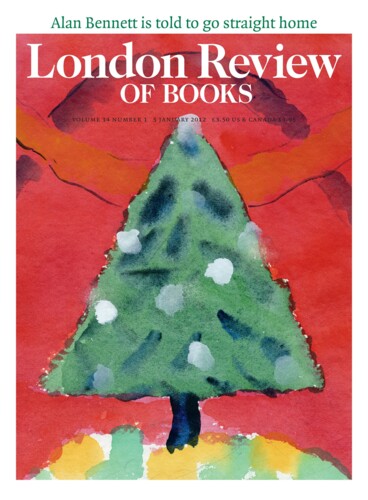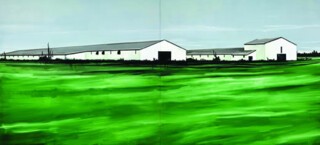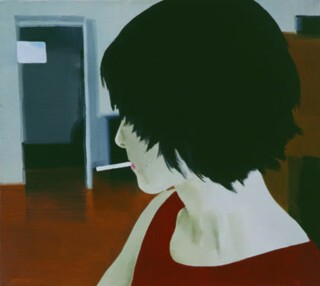The exhibition at the Whitechapel Gallery (until 1 January), surveying ten years’ work by the 38-year-old Polish painter Wilhelm Sasnal, gets other painters arguing. Everyone has their dislikes. Mine is the largest and most recent canvas, Pigsty. Black lines pick out a long low agricultural compound – whitewashed walls pierced by thin black windows – that stretches some 13 feet between a grey sky and the heavy green of the Polish plains. This foreground swathe of green, streaked at high speed with a six-inch brush, strikes me as phoney. ‘I’m urgent and desperate,’ it shouts. No, no, I say, you’re frantic and contrived. You’re trying to foist emotion on the sullen subject the artist has chosen to depict: and in doing so, you give the game away – why this agro-industrial pigsty has been invested with such monumentality. Inescapably, it becomes clear that Sasnal has been drawn to the image by its Auschwitz-like-ness. Reaching back to the zero hour of his grandparents’ generation, he is making a stab at a Great Polish History Painting. But that schlocky slither of Hooker’s Green suggests to me that you can no longer rely on a seven-decades-old trauma to locate your nation’s emotional truths.
Poles were ‘pigs’ in Maus, Art Spiegelman’s animal parable of the Holocaust, and it was for small canvases based on that graphic novel that Sasnal started to get noticed ten years ago. Blowing up Spiegelman’s black and white frames with their captions removed, Sasnal nudged at the story’s grim content with the tersest of signifiers. One way, this was a quizzical take on the notion that painting might report on history: another, it was a fan’s tribute handiwork. So much in this show is fed by fandom, by submission to this or that allure. Sasnal, born in the southern industrial city of Tarnów, got into art by copying album covers, and when he paints now he is still most often working from some image that grabs him. The cues he employs in this exhibition include Seurat’s Bathers at Asnières, a Mexican photographer’s shots of accidents and suicides, downloads from a Google search for images of the Japanese tsunami, a shop fascia and holiday snaps of his wife and kids. All these are felt for as imagination-snagging glitches in the contemporary visual flow. Sasnal’s quality of attention is not far from that of the photographer Wolfgang Tillmans: ‘From the day I recognise that something has meaning to me I hold on to it, saying: “If this matters to me now, then I hope it will matter to me in the future.”’ Sasnal shares the slightly older Tillmans’s brisk, omnivorous curiosity, his will to be surprised: one reason why the Whitechapel exhibition, with all its fallibility, exhilarates me.
Tillmans wants to organise an encyclopedia of his findings. Sasnal, I feel, just needs reasons to pick a fight. An image grabs him and he grabs back, ferociously. The objective, he claims, is to dispatch each painting in a few hours’ studio wrestling. He snatches at hints of line and texture in his source photographs and interrogates them until each has been pinned down as a distinct statement on the canvas, or else dismissed and angrily erased. The hunt for idioms to tackle the various things that bother him embraces every gesture in the gamut of contemporary brushwork. By turns scratchy, splurty, swishy or scrawny, his paint surfaces offer a bracing antidote to those of the Tate’s Richter retrospective, with their numbing, overpowering homogeneities.
Sasnal’s irritability irritates and sets us arguing. The reason we bother to argue is that he hits home so often. Reproductions of his canvases – for instance the exhibition’s poster image of a child standing in front of the sun – can mislead, reassimilating them to the photos they started from: it’s what happens in between that matters. In the flesh, a single beautifully judged swipe of washed-out Indian Red, tracing the collar of the child’s T-shirt, jumpstarts the picture into succulent immediacy. Likewise, Sasnal has unique ways of rendering the bristliness of hair and grass. He has a territory all his own in Polish church interiors, and his little canvases of them are almost William Nicholson-exquisite. There is a tiny, impassioned wedge of orange between the chin and neck in Anka, a portrait of his wife, for which I would gladly forsake every abstract Richter ever painted.
It’s doubtful, though, that this kind of success – the capacity to make a certain passage of paint spring to life – still counts as success on any respectable level. ‘I know nothing about opera,’ this fan of Roy Orbison and Bowie remarks, ‘but I still think that painting is like opera, it’s artificial, an old-fashioned activity.’ What then does he think he’s reaching out for, crossing that divide? The answer sometimes comes with existential pretensions: by way of all this translation and subtractive editing and rematerialisation of visual information, Sasnal might be hitting on the surd qualities, the deep obduracy and mystery of ‘being in the world’. Or maybe, rather, of ‘contemporary experience’, a style of reply that readily slips into styles of pathos: painting as a resistance to the multi-mediated alienation, or even a register of the guilt in which we all somehow flounder. Hence the prodding at Holocaust themes, or at the face of a pretty mass murderer from Rwanda.
To put it politely, this is all latecomer’s rhetoric. Luc Tuymans staked out this territory a generation earlier. (Indeed, the over-scaled débâcle of Sasnal’s 2011 Pigsty recapitulates that of Tuymans’s 2002 Still Life.) And from the generation before that, Richter’s portrait of his daughter Betty, turning away from the painter, unmistakably looms over the Anka I’m so fond of. But there’s another thing that’s only doubtfully important these days, and that’s originality. Sasnal’s status as a representative European of the noughties, a fan and screen-surfer susceptible to every cross-current of the era, feels perfectly respectable. He makes it tenable by his determined, constantly inquisitive productivity.
From an English perspective, one sees a distinctive Polish will to persist in that. Art as a burden and a responsibility seems to weigh heavier in the land of Bruno Schulz and Miroslaw Balka. Like others in his generation of Polish painters, Sasnal does most of his thinking in black paint. ‘Colour should serve some purpose,’ he pronounces sternly. ‘If I use some colour, it’s to emphasise something and not to make the picture colourful.’ He emphasises and he invigorates. We’ll be seeing a lot of that black in next year’s degree shows.
Send Letters To:
The Editor
London Review of Books,
28 Little Russell Street
London, WC1A 2HN
letters@lrb.co.uk
Please include name, address, and a telephone number.



